6+ Sample Music Concert Proposal
-
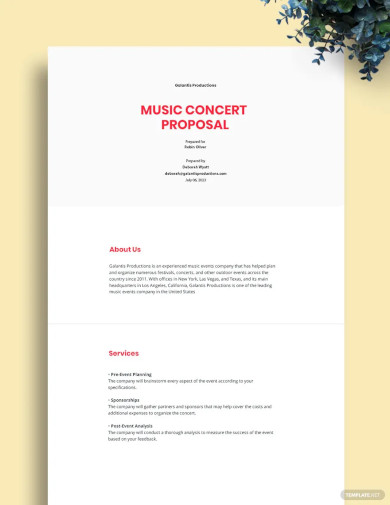
Free Music Concert Proposal Template
download now -
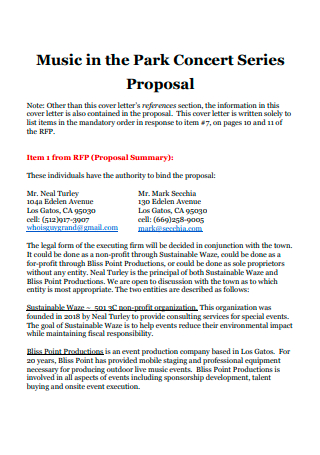
Music in the Park Concert Series Proposal
download now -
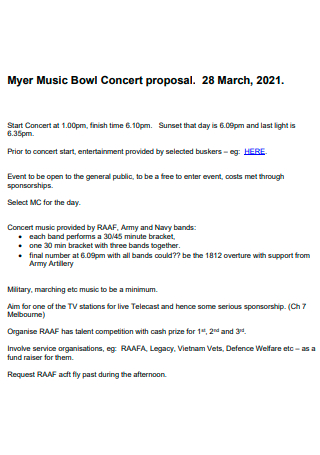
Music Bowl Concert Proposal
download now -

Basic Music Concert Proposal
download now -
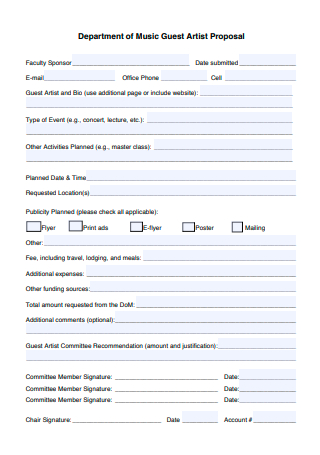
Music Concert Guest Artist Proposal
download now -
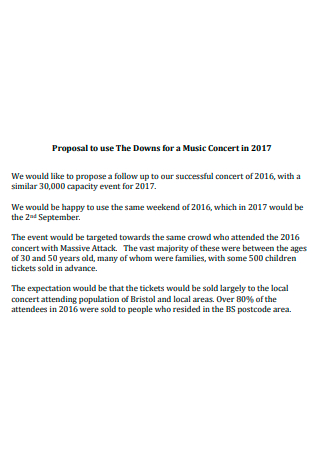
Music Concert Proposal Example
download now -
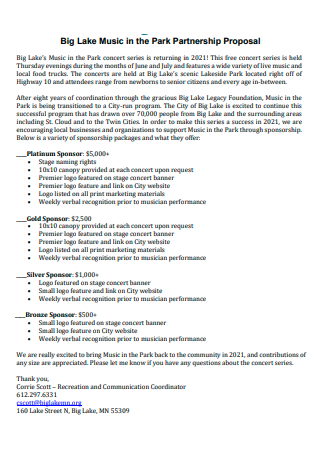
Music in the Park Partnership Concert Proposal
download now
FREE Music Concert Proposal s to Download
6+ Sample Music Concert Proposal
What Is a Music Concert Proposal?
Different Types of Classical Concerts
Genres in the Music Industry
How to Write a Music Concert Proposal
FAQs
How long is a concert?
How do music venues make money?
What is the purpose of the concert?
What Is a Music Concert Proposal?
The term music concert refers to audiovisual content that consists only of musical performances by one or more musicians. Award shows, other variety shows, and other live events that may involve musical performances are usually not included because they often belong to another category and could cause confusion. But forming these music concerts is not easy and could require numerous efforts to merely plan one. This is where a music event proposal comes into the picture as it will help in organizing the necessary parts of a concert. Proceed to view the available music concert proposal sample before writing one.
Different Types of Classical Concerts
Who doesn’t enjoy a good show? You can’t deny that there’s a sense of shared excitement when you are surrounded by a group of admirers who are engulfed by the music you enjoy. Particularly the group that you will get along with for sharing the same interest in that specific music. Each style of the concert, on the other hand, has a distinct atmosphere. And before you draft out your music concert proposal, it is vital for you to be aware of the different types. Give this article for a rundown on the few different types of concerts participants could attend.
Genres in the Music Industry
A Music genre is a term used to classify certain types of music as belonging to a common tradition or set of rules. Music can be classified into several genres in a variety of ways. Since music is an artistic medium, these categories are frequently subjective and contentious, and some genres may overlap.
How to Write a Music Concert Proposal
While there are no formal forms that must be followed while writing a proposal, most proposals have one thing in common: they strive to make the reader aware of the significant components. The reasons for writing a proposal can also differ, which can influence the proposal’s format. The presentation may be more formal if you are self-funded and the proposal is mostly for internal use than if you are presenting the proposal for a concert sponsorship proposal, need money, or are staging a show as part of your employees working for a company. Proceed to view the sample of the music concert proposal to use as a reference.
Step 1: Create an Introduction
Many shows or concerts have names. You must have a title on either the cover page or header in this case, with the event’s name in capital letters but if the show has no formal name, you can opt to write to include the city or venue’s name or both. Typically, a few phrases describing the concert are adequate. Include the rationale after that. When expressing your rationale, you might find it helpful to refer back to the self-assessment from the prior module. It will also be vital to think about the sponsor’s or sponsors’ aims, if applicable to the case.
Step 2: Elaborate on the Event Details
For the next step, you will need to define the type of event you are proposing. As you can see, there are various classical concerts and even other types. Narrow down on the specific type so that readers will be aware of what to expect. You should also mention the city, town hall, or staging area. If it hasn’t been chosen, at the very least, the general characteristics should be specified. This would include topics like seating capacity as well as compatibility with the target audience and artists. Make sure the day you choose doesn’t conflict with the weather or any known holidays.
Step 3: List Out the Budgeting Needs
A line item is usually included in a budget proposal. This is simply a list of all of your expenses, organized by category, and then totaled up. For a proposal, it is only expected that you will estimate the expenses as carefully as possible. Many actual expenses may change or not fall in line with your expectation. Before evaluating costs, it’s a good idea to do some study. If you know how your financing will be secured, you should also give that information. You can opt to include a graph that could help the reader comprehend the budget much easier.
Step 4: Prepare Samples of Work
Programs such as song orders, music videos proposal or recordings of prior shows or rehearsals, marketing materials, contracts, or invoices are all examples of sample works you can include in your proposal. These should be of the finest quality available and are presented to offer confidence in your capacity to deliver the show following your proposal. It is okay to use reference materials demonstrating the work of others if you do not have your materials, as long as you declare this. Adding in samples of your work will help readers or sponsors to be persuaded to accept your document.
Step 5: Reach Out for Sponsorships
In the concert industry, sponsors and sponsorships play a huge role. Concerts would not be possible without the support of a sponsor in many circumstances. Corporations, governments or municipalities, cultural organizations, educational institutions, service providers, Charity foundations, and even individuals are examples of potential sponsors. Sponsors may wish to be involved with your musical production for a variety of reasons, and there are numerous methods for them to do so. The producer frequently should grasp the motivations and capacities of sponsors and make a feasible proposition to them as a result. The bottom line is that any indie artist will appreciate an extra amount.
Step 6: Discuss Your Marketing Plan
For the last step and after reaching out to sponsors to lay out what your proposal’s contents are, you will need to show them that you also have the plan to market your music concert. Since some audiences are already participating, such as during a conference, not every concert will require a marketing plan. If a marketing campaign is required, you should offer a summary of the techniques and channels you intend to employ. This plan would pay special attention to demographic factors. The main purpose of having a marketing plan is to reach a wider and larger number of audiences to gain more attention.
FAQs
How long is a concert?
Since there are various types of concerts, there are also different durations. For a lesser-known artist or group, shorter concerts could be as short as 20 minutes. For someone more well-known but not yet deserving of legendary status, it could take up to an hour. Well-known musicians and those who have truly earned legend status will usually perform for longer periods, such as 90 minutes or even several hours. Many concerts feature more than simply an opener and a headliner, which are known as multiple-set events.
How do music venues make money?
Music venues, like movie theaters, generate a significant portion of their revenue from the selling of refreshments, in this case, beverages of various types such as cola or juice. Sometimes also offering food snacks. Another avenue these music venues gain money is through the tickets that are sold during the music concert. Similarly, the portions gained may be given to a charity concert or benefit concert where advocacy is tied to the concert.
What is the purpose of the concert?
Concert performance is at the heart of what music instructors and their students have on their agendas in most, if not all, school music programs. Music educators devote a significant amount of effort to organizing and rehearsing concert programs, always with the goal of successful performance in mind.
Reading through this article will thoroughly help you to write your music concert proposal along with the provided concert proposal template, you won’t have to worry about starting from scratch. Keep in mind that the music event proposal sample will also come in handy as a reference. Make sure to go over the guide as well since it will show you the basic components of a proposal. What are you waiting for? Begin making that proposal now so you can start that music concert and begin gathering audiences!
